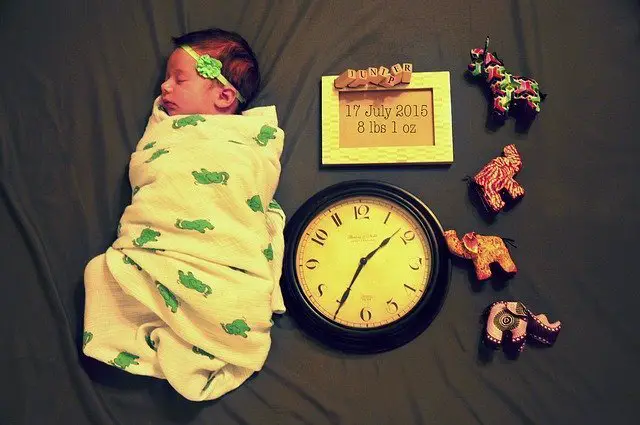The question about knowing when to stop swaddling your baby may not have a very definite answer as babies are unique and develop at their own pace. Different parents have their own views as to when to stop swaddling a baby. Some think it should last till about 4 to 6 months, while others think stopping at 2 months is just perfect.
Hey! By the way… any links on this page that lead to products on Amazon are affiliate links and I earn a commission if you make a purchase. Thanks in advance – I really appreciate it! .
It is common knowledge that swaddling helps newly born babies to sleep better, protect them against harsh weather by giving them necessary heat and comfort, and at the same time, prevent baby incessant cries and mother’s tiredness. Knowing the exact time to stop swaddling your baby is as important as swaddling your baby at all.
Here are the general guidelines and tips applicable for you to easily know the time to stop swaddling your baby:
Signs to consider before you stop swaddling your baby
Usually, people stick with a 4 to 6 months rule, like it was mentioned earlier in the article. However, it is better to understand that the timing for each baby can vary, and the ability to figure out the right signal from your baby can be more helpful in determining the actual time to stop swaddling.
Hence, it is high time you stop the act of swaddling when your baby displays some of these signs:
Frequent movement of the body and limb during mid-sleep
One of the many reasons for swaddling babies is to let them maintain and enjoy the similar cushy sensation of the womb. However, the moment you notice your baby is constantly moving his body and limb by rolling over while swaddled; just know the time is right to stop the act of swaddling. This is because, the minute your baby starts rolling over, he needs his arms and legs to adjust himself or his position. Otherwise, suffocation could arise, if your baby rolls with his face down or directly on the bed.
Resisting being swaddled
Another significant sign to consider is when your baby is showing resistance to swaddling. This is not just a sign that your baby is growing, but also an indication that your baby wants to move around, and using his hands or legs to resist swaddling means, it is high time to stop. Your persistence to swaddle your baby can lead to incessant cries and even lesser sleep for the baby.
Repeating rollover of the baby
It is normal to be confused or seek to know the right time to stop swaddling your baby. What is odd, however, is having all the signals of when to stop, but you could not decipher it. The ideal sleeping position for a baby is lying on his back, but when you start noticing your baby is constantly changing position and rolling over, by waking up to see that he is lying on his stomach. Then, the time is right to stop swaddling your baby. You do not necessarily need to wait until the usual six months; this could happen after three months as well.
There are series of wake ups during the middle of the night
Although, it is true that babies do not have sleeping patterns until about three to six months after birth. It is, however, necessary to note that, by the time you notice your baby keeps getting up during the night sleep, over and over, following a period of sleeping well, this could be a signal of when to stop swaddling your baby. This probably indicates that your baby needs to move around or roll over in bed, but he is finding it difficult to do so, because of being swaddled.
There is little or zero startle reflex
Moro or Startle reflex is a common phenomenon in babies. It normally occurs around 28 to 32 weeks after birth and expected to stop at around age 3 to 6 months. It is basically a form of babies’ reaction to an acute fall, by spreading their arms and legs prior to moving their arms ahead of their body. This swift reaction is the baby’s primary struggle to safeguard himself and question the ambit of his world.
Hence, swaddling a baby helps to prevent the activation of Moro or Startle reflex. However, since this reflex normally disappears after 3 to 6 months, it is expected to consider when to stop swaddling your baby during this period. This is because; swaddling your baby at this time may turn dangerous as your baby advances in age and becomes more active in moving around.
Displaying too-much mobility to remain swaddled all night long.
It has been concluded through various research studies that parents should adopt swaddling for a baby, to have a sound sleep and to prevent triggering of Moro or Startle reflex. But most importantly, parents should also let the baby have more time and space when not sleeping to turn inside out and move around. Hence, the moment you notice your baby displaying so much mobility, by moving arms and legs often, and at the same time rolling over. It is believed that is when to stop swaddling your baby in order to prevent a form of hip dysplasia.
Conclusion
Throughout the article, it has been established that swaddling your baby is as important as knowing the time to stop swaddling your baby. This helps to prevent the catastrophes that may occur in swaddling your baby more than necessary, such as suffocation through mattress or blanket, Sudden Infant Death Syndrome otherwise known as SIDS, hip dysplasia, etc.
Also, parents should understand that each baby is different, and there is no single answer as to when to stop swaddling your baby, but by following the aforementioned guidelines and tips, it gets easier to anticipate and know when to act accordingly.
Finally, following all these guidelines and tips requires great attention and observation, so it is advisable to be calm and persistent, to determine exactly when to stop swaddling your baby.


